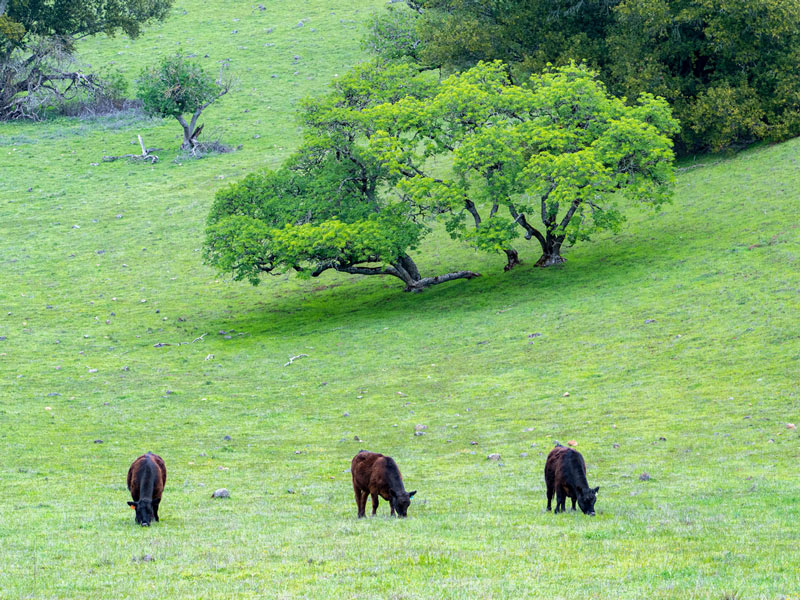Here’s How Ranching Helps Marin’s Biodiversity

By Matt Dolkas,
Senior Manager, Marketing
January 12, 2024
This is the place.
California is renowned for its rich biological diversity—with one of the greatest varieties of plants, animals, fungi, algae, and microorganisms—of any corner on the planet. As one of the world’s 36 biodiversity hotspots, the Golden State boasts more native plant species than any other state in the country. That’s right, you’re living in an ecological paradise.
Our responsibility to tend to this landscape and its biodiversity is increasingly important. Over a million species are at risk of extinction globally, and scientists warn that each degree of planetary warming increases the risk of species extinction. The time for conservation is now.
California has made great strides in biodiversity conservation, with more land under biodiversity protections than any of the other lower 48 states. But it’s also home to the highest concentrations of imperiled species that live outside of those protected areas.
The clock is ticking and we have a lot to lose.
New research from NatureServe and The Nature Conservancy shows that California has the most imperiled biodiversity of any state in the contiguous U.S.
What is Biodiversity, Again?
Biodiversity—short for “biological diversity”—refers to the variety of life in the world or in a particular habitat or ecosystem. It’s one of those words that has a hard time holding the weight of its meaning, as the relationships between species and communities of species are equally important in its definition. Each species is valued both individually and in its interaction with and influence over others. In other words, biodiversity describes a total greater than the sum of its parts.
Why is Marin County So Biologically Rich?
With its unique combination of climatic, topographic, and geologic diversity, Marin County supports a tremendous variety of habitats. Since different species have different strategies and requirements for survival, reproduction, and finding food, a variety of habitats ensures that multiple species can coexist in an ecosystem.
Plant species, for example, closely follow shifts in moisture and temperature, inhabiting suitable niches amid each bend and twist in the landscape. With so much habitat variability in Marin County, there is an abundance of suitable refugia for a wide range of life.
You can see this variety across the landscape on your next adventure. Towering redwoods nestle along the shaded creek beds of Samuel P. Taylor State Park, while sunbound manzanita flourish along the south facing slopes nearby. It’s this range of habitats that provide the foundation for one of the world’s most biologically diverse ecosystems.
In 2020, both the federal and state governments committed to protecting 30% of all land and water by 2030, what’s colloquially known as the 30×30 initiatives. These efforts recognize the role of land conservation in safeguarding our precious biodiversity.
How Do We Protect Biodiversity?
Conserving large landscapes and protecting them from development is a critical first step in biodiversity conservation. It’s about securing the room life needs to roam, and is part of the reason we have worked to conserve so much of Marin County’s working and natural lands—to preserve Marin’s natural heritage.
But protecting land from development is just the first step. Stewardship of the land is essential to ensure the highest number of habitats are sustained. We can help cultivate conditions needed for flora and fauna to thrive and, in doing so, sustain these biodiversity hotspots.
Why is Ranching Critical for Marin’s Biological Preservation?
If you could climb inside a time capsule and travel back to before European-American colonization, you would find that a lot of Marin County was perennial grassland, grazed by native herbivores like elk and deer. But it wasn’t the untouched wilderness you might imagine.
For millennia, Indigenous people tended this landscape, regularly burning with low-intensity fires (and they still do) to encourage the growth of preferred plants as well as to create open spaces for hunting. The native plants here are not only adapted to fire and grazing, they thrive on it.
Fast forwarding in time, with European-American colonization came the reduction of native grazers and the extinguishment of traditional management practices by native people. Europeans also introduced non-native grasses to California that dramatically altered the state’s ecosystems – today, less than 1% of California native grasslands remains. Most of the grasslands you see today here are fundamentally altered from the landscape 500 years ago.
So, where does this leave us?

When well-managed, livestock help to maintain more open, healthy grasslands. And through rotational grazing practices—strategic and well-time movement of stock—ranchers are able to stimulate microbial activity in the soil and beat back encroaching woody shrubs.
Livestock are now our best proxy to help keep this landscape in balance. Without ranching in Marin County, our native grasslands would be overtaken by invasive European grasses. In other places, the lack of disturbance would allow larger species like coyote bush and Douglas fir to encroach and take over. Well-managed grazing provides the level of disturbance this landscape depends upon to remain as grassland.
Sustaining our local grasslands is essential for biodiversity conservation. California’s coastal prairie ecosystem harbors the most species-rich grassland in all of North America, life thrives along the continent’s wild edge. And with this tremendous natural wealth in Marin County comes an oversized responsibility to tend to this landscape, something we can only do in partnership with our ranching community.